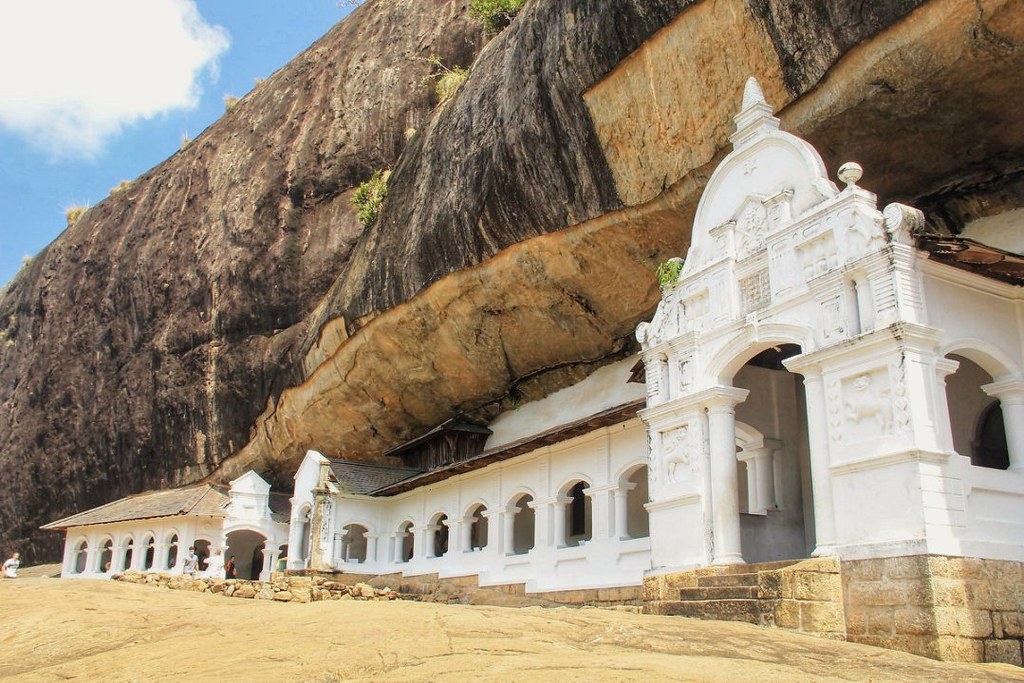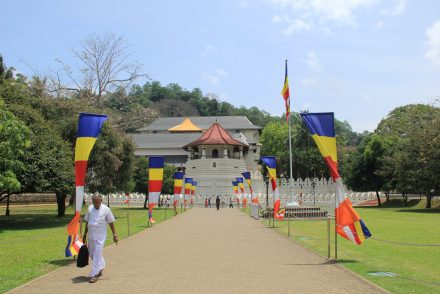If you’re thinking about visiting the Dambulla Cave Temple in Sri Lanka then this helpful little guide has you covered! So, if you’re after some practical information (such as how to get to the Dambulla Cave Temple or the Dambulla Cave Temple entrance fee), along with a first-hand account of what you can expect from your visit, then you’ve come to the right place.
Some of the links in this post are affiliate links. All this means is that if you make a purchase through one of the links I have provided, I will earn a small commission as a result but the cost to you will remain exactly the same.
You’ll probably be familiar with the spectacular Buddha-filled interior of the Dambulla Cave Temple long before you arrive in Sri Lanka. It’s the largest, best-preserved cave temple complex in the country. The five separate caves contain over 150 Buddha images and statues, some dating back 2000 years.
Inhabited by forest-dwelling Buddhist monks since the third century BC, the Dambulla Cave Temple has been a sacred pilgrimage site for 22 centuries. Also known as the Golden Temple of Dambulla, the Dambulla Cave Temple obtained World Heritage status in 1991.
You’ll find the Dambulla Cave Temple half the way up a hilltop, some 160 metres above Dambulla town. Its location affords some incredible panoramic views of the surrounding plains, including Lion Rock in Sigiriya, 19 kilometres away.
What’s the best way to get to the Dambulla Cave Temple?
The Dambulla Cave Temple is probably not the only site you’re visiting in the area. I imagine you’ll be basing yourself in either Dambulla, Habarana or Sigiriya, in order to visit one of Sri Lanka’s ancient cities and to climb the famous Lion Rock as well.
From Sigiriya | This is where I travelled from. You can either hop in a tuk-tuk to Inamaluwa Junction (around 500 LKR) and then pick up a bus heading in the direction of Dambulla or you can get a tuk-tuk the whole way. If you’re catching a bus, you’ll want one heading in the direction of Colombo Fort. It takes around 25 minutes to get to Dambulla town and from there it’s a short walk (if you jump off at the bus stop by the Conservation and Research Centre and Painting Museum) up to the Dambulla Cave Temple.
If you choose to make the 17 kilometre journey in a tuk-tuk, it’s usually cheaper to negotiate a return journey rather than two single journeys. The driver will wait for you just below the entrance and take you back when you’re ready. I paid 2000 LKR (around £8) for this service.
From Dambulla | The Dambulla Cave Temple complex is located in the southern part of Dambulla, so how far you’ll need to walk to get there depends upon where you’re staying in town. Two of the closest accommodation options to the temple complex are Sundaras Resort and Spa (which isn’t actually as expensive as it sounds) and Vihangi Guest House (a more budget-friendly option). From the latter it’s approximately 600 metres to the Dambulla Cave Temple entrance.
The exact location of the Dambulla Cave Temple complex is shown on the map below.
From Habarana | There is a bus that runs directly from Habarana to Dambulla, with a journey time of approximately 40 minutes. You’ll need to make your way to Habarana Junction (the crossroads in the centre of town) to pick up a bus heading in the direction of Dambulla. It’s the same one you’d catch from the Imanaluwa Junction if you were coming from Sigiriya, so the final destination will be marked as Colombo Fort.
What is the Dambulla Cave Temple entrance fee?
When I visited in March 2020, the Dambulla Cave Temple entrance fee was 1500 LKR (£6.22).
When compared to the entrance fees to the ancient city of Polonnaruwa and to to Lion Rock in Sigiriya, the Dambulla Cave Temple entrance fee is actually really reasonable.
You will be required to take your shoes off before you enter the temple complex, so you’ll also need some small change to leave as a donation when you collect them after your visit.
How long do I need to allow for my visit?
There are just five temples to visit, so it’s not a huge complex. I took my time, snapped way too many photos both of inside the temples and of the incredible views surrounding the complex AND got distracted by monkeys, and I still made it back down to the entrance in about one and a half hours. So, I’d say you don’t need to allow for any more than two hours at the very maximum.
What are the opening hours?
The Dambulla Cave Temple is open every day from 07:00-19:00 hours.
Is the Dambulla Cave Temple accessible?
Unfortunately not. Once you’ve bought your ticket from the ticket office, there are A LOT of steps (364 in total) to climb to reach the main temple complex.
Given Sri Lanka’s high humidity, climbing 364 steps is no walk in the park, even for those who are physically able. I found myself having to take a break part the way up, and this is from someone who goes on regular hiking adventures and runs three or four times a week!
But on the plus side, the views are definitely worth stopping to admire.
What is there to see inside the Dambulla Cave Temple complex?
As I mentioned previously, there are five separate caves to explore. Once you pass through the main entrance gate, you’ll find yourself in an internal courtyard area, walking on top of a giant rock and with another one towering right above you.
The whitewashed structure below (which looks as though it’s being eaten by the cave mouth) is your entrance to the caves. There’s a lovely long corridor that provides some welcome shade from the heat outside.
My advice would be to start at the far end and then work your way back towards the entrance. This way you begin with the smaller caves and then work up to the larger ones with the most impressive statues and images.
You may find it useful to bring a torch because some of the temples are pretty dark inside. Having a tiny bit of extra light allows you to pick out so much more detail in the images and sculptures. Just be aware of those taking photographs around you when you’re using it, and be prepared to switch it off when necessary.
You’ll also want to bear in mind when exploring the temples that it is considered rude to turn your back on Buddha statues. Whilst it may seem impossible to respect this tradition with so many Buddha statues in each cave, is is possible to back away from a statue to a reasonable distance before turning around. Hopefully there won’t be too many people inside the cave for you to bump into as you do so!
Although, there will probably be a few more than I encountered.
I think that, due to travelling in Sri Lanka when the WHO declared COVID-19 a pandemic, tourist numbers were a lot lower than usual when I visited. In fact, the Dambulla Cave Temple was officially closed to visitors just days after I walked through its entrance gates. I was quite lucky to have made it there at all.
If you’re a keen photographer, you’ll want to pack your wide angle lens and tripod when you head out to the Dambulla Cave Temple. Shooting with a standard lens (as I did) means you’ll only be able to capture a small corner of each Buddha-filled cave, and without a tripod it will have to be a well-lit corner, too.
The majority of the decent photos you see of the Dambulla Cave Temple online have been shot using both.
Don’t forget to look up as you wander around inside the temples; the ceiling frescoes are as impressive – if not even more so – than the Buddha statues themselves.
Because of how uneven the ceilings are (it being a cave ‘n’ all), it almost looks as though a giant piece of colourful woven fabric has been used to cover the actual ceiling. But no, these are in fact frescos painted delicately and expertly directly on to the cave stone.
I cannot even begin to imagine how many painstaking hours it took to complete these frescoes – a feat which is especially remarkable when you consider that they were first painted in an age prior to the advent of artificial light.
Where there are temples, there are monkeys!
Oddly enough, I didn’t spot any on my climb up to the temple, but on my descent I literally found myself surrounded by monkeys everywhere I looked, and couldn’t resist stopping every few moments to photograph or film them. There were mothers grooming their less-than-impressed-by-the-whole-ordeal young, and those who had managed to escape the grooming ritual were bounding from tree branches to walls to steps to rooftops, chasing and taunting each other as they did so.
I could honestly watch monkeys all day long, I find them fascinating and amusing in equal measures.
Much as I didn’t want to drag myself away from the monkeys, I’d seen what I’d come here to see and loved every minute of it!
So, I headed back down towards the car park where my driver was waiting to take me back to Sigiriya. But the day wasn’t over yet: ahead of me was a visit to Sigiriya’s ancient fortress and a climb up to the top of Lion Rock in time for sunset.
Stay tuned for my next post to read more 😊
If you like this article, please share it on social media using the share buttons at the top of the post. And if you’d like to save it for reading later, why not pin to one of your Pinterest boards? Alternatively you can follow along on Facebook and Twitter, or you can look me up on Instagram or Pinterest too!

















No Comments